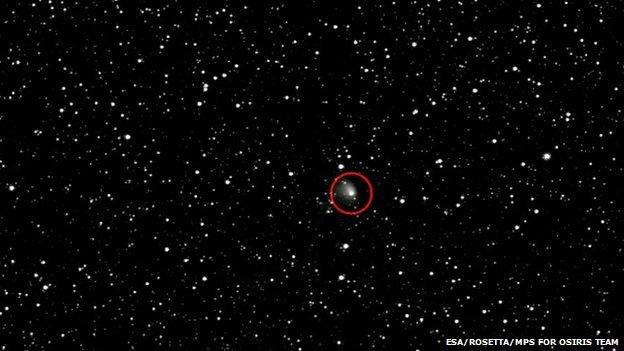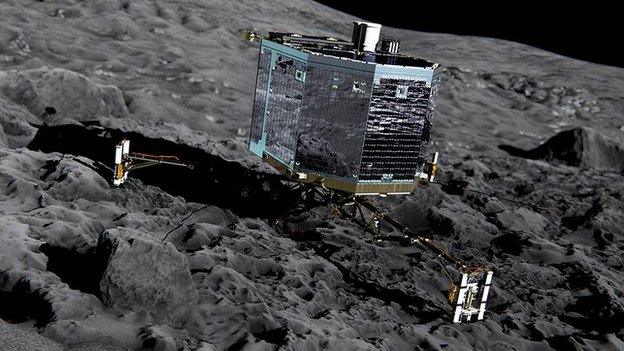Rosetta comet-chaser initiates 'big burn'
- Published

67P/Churyumov–Gerasimenko already shows signs of a developing halo, or coma, around its nucleus
Europe's Rosetta spacecraft is in the midst of another critical moment in its mission to rendezvous with a comet.
The satellite has lit its thrusters for a near-eight-hour burn that should put it on just the right path to meet up with 67P/C-G in August.
Although eight further manoeuvres will be required to complete the task, Wednesday's is the big one.
Rosetta, which was launched from Earth 10 years ago, plans to orbit the comet and put a small lander on its surface.
If all goes well, the mission should return some remarkable insights on the behaviour and chemical make-up of its icy quarry.
Rosetta's automated systems initiated the thruster firing at 15:23 GMT (16:23 BST; 17:23 CEST).
'Fundamental' burn
Engineers at the European Space Agency's (Esa) "mission control" in Darmstadt, Germany, received confirmation some 28 minutes later.
The delay was down to the time it takes for signals to travel 500 million km - the current distance between Rosetta and Earth.
"#BigBurn has started! #Rosetta team at ESOC seeing good telemetry," the control room's Twitter feed reported, external.

Controllers followed the performance of the thrusters on their telemetry feed
"@ESA_Rosetta mission control seeing thruster temperatures rise as they heat up, 500mln km away #BigBurn," it added.
Comet 67P/C-G is travelling around the Sun on a big loop that takes it out beyond the orbit of Jupiter and then back in to just inside the orbit of Mars.
Rosetta is attempting to target its rendezvous at the start of the inward curve, before our star can warm the 4km-wide body and trigger large jets of gas and dust from its surface.
At the moment, the separation between the pair is about one million km, and closing.
Wednesday's burn is designed to slow Rosetta's velocity relative to the comet and thus keep it on a trajectory to arrive just in front of the object in 11 weeks' time.
The idea by then is to have reduced the relative velocity from the present 755m/s down to just 1m/s, with a separation under 200km.
Relative to the Sun, of course, their speed will not be "walking pace" - rather, the duo will be hurtling through space at more than 13km/s as they fall deeper and deeper into our star's gravity well.
Even though engineers conducted a small test burn two weeks ago, there was a little nervousness at the European Space Operations Centre ahead of Wednesday's manoeuvre.
That was because Rosetta has a leak in the system it uses to pressurise its propulsion tanks.
'Sneezing' risk
Pressurising the propellant ensures there is a steady, even flow of fluid into the combustion chambers of the thrusters.
This leak has been known about for some years, and engineers believe they understand it and can work around it.
But if a problem is to show itself, it could well be during the big burn.
"Operating at a lower pressure leads to less efficient combustion, and that means using more propellant. But this is OK because thanks to our good and accurate navigation, we have more than enough reserve to cope with this," explained Andrea Accomazzo, Esa's Rosetta Flight Director.
"What is really more of a risk is that at low pressure the thrusters can operate more like they're sneezing than burning. It could make the combustion very rough - very variable."
The Darmstadt team will be watching the telemetry from Rosetta very carefully to assess the stability of the four 10-newton thrusters being used during Wednesday's firing sequence.
Following the burn, scientists will take new pictures of the comet with Rosetta's Osiris camera.
These images will help gauge better the comet's exact position on the sky so that the next, slightly smaller burn, planned for 4 June, can be executed properly.


Rosetta will attempt to put the Philae lander on the comet's surface in November
Jonathan.Amos-INTERNET@bbc.co.uk and follow me on Twitter: @BBCAmos, external
- Published7 May 2014

- Published28 March 2014

- Published21 March 2014

- Published20 January 2014

- Published10 December 2013

- Published18 September 2013
- Published29 March 2012